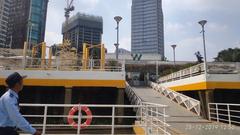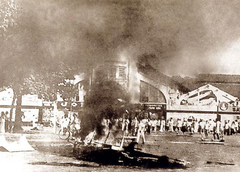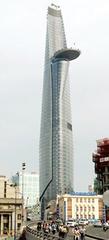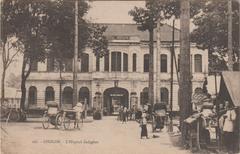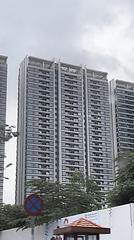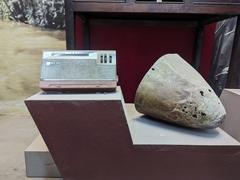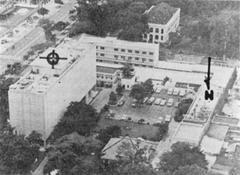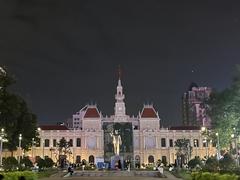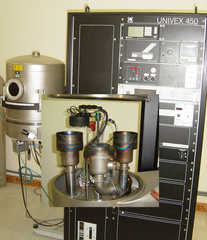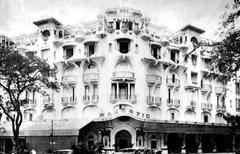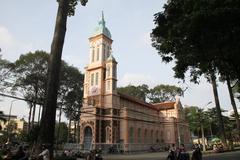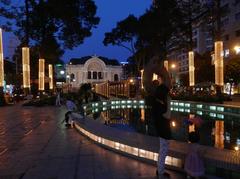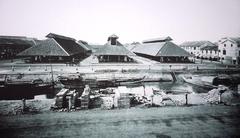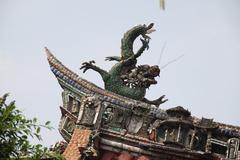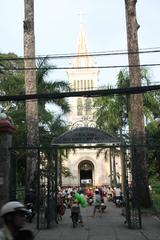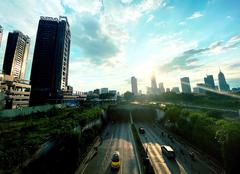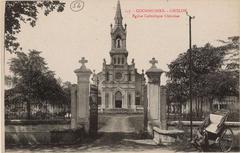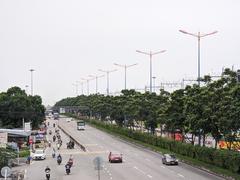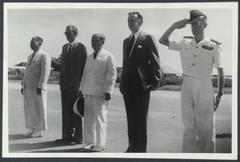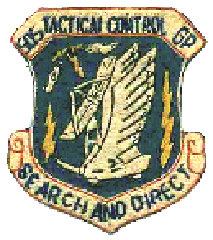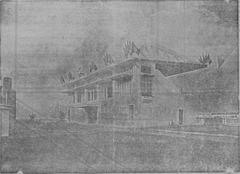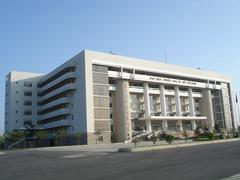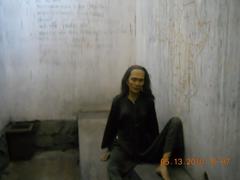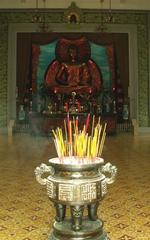Mạc Đĩnh Chi Cemetery Visiting Hours, Tickets, and Guide: Exploring a Lost Landmark of Ho Chi Minh City
Date: 04/07/2025
Introduction
Mạc Đĩnh Chi Cemetery, once a grand colonial-era necropolis in the heart of Ho Chi Minh City (formerly Saigon), stands as a poignant symbol of the city’s layered history. Though physically absent since the 1980s, its legacy remains deeply woven into Vietnam’s cultural and political fabric. This comprehensive guide explores the cemetery’s origins, evolution, demolition, and enduring significance—while offering practical information for visitors seeking to connect with Ho Chi Minh City’s past through its present-day green space, Lê Văn Tám Park.
Table of Contents
- Historical Overview
- Visiting the Site Today
- Nearby Historical Attractions
- Cultural Significance and Legacy
- Environmental and Urban Planning Context
- Frequently Asked Questions (FAQ)
- Visuals and Resources
- Plan Your Visit & Responsible Tourism
- References
Historical Overview
Establishment and Colonial Era
Founded in 1859 by French colonial authorities as the Cimetière Européen (also known as Massiges Cemetery), Mạc Đĩnh Chi Cemetery quickly became the principal burial ground for French officials, expatriates, and later, Vietnamese elites (Historic Vietnam). Designed in the tradition of European garden cemeteries, it featured winding paths, eucalyptus trees, and ornate mausoleums, reflecting a blend of French, Vietnamese, and Chinese architectural styles (Saigoneer).
Notable interments included French naval officers, missionaries, and later, prominent Vietnamese such as President Ngô Đình Diệm and his brother Ngô Đình Nhu. The cemetery’s location, near today’s US Consulate and Notre-Dame Cathedral Basilica, underscored its central role in the city’s colonial and social landscape (dbpedia.org; Wikipedia).
The Republic of Vietnam Period
After French rule ended, the cemetery was renamed in 1955 for the scholar Mạc Đĩnh Chi. It remained the city’s most prestigious burial ground, with elaborate mausoleums constructed to honor South Vietnamese leaders and influential families (Saigoneer). The cemetery played host to state funerals and memorials, including ceremonies for political figures during the turbulent Vietnam War years (Find a Grave).
Demolition and Transformation
Following the reunification of Vietnam in 1975, the new government viewed the cemetery as a relic of colonialism and old regime authority. In 1983, Mạc Đĩnh Chi Cemetery was officially closed; families were instructed to relocate remains, while unclaimed graves were exhumed or cremated. By 1985, the land was cleared and redeveloped as Lê Văn Tám Park—a green lung for the city and a symbol of postwar urban renewal (Vietnam Discovery; Ahoy Vietnam).
Visiting the Site Today
While the cemetery itself is gone, its location—now Lê Văn Tám Park—remains a tranquil oasis amid Ho Chi Minh City’s urban bustle.
Location and Accessibility
Address: Intersection of Điện Biên Phủ and Võ Thị Sáu streets, District 1, Ho Chi Minh City.
How to Get There:
- Taxi/Ride-hailing: Enter “Lê Văn Tám Park” into any major app.
- Public Bus: Multiple routes serve District 1 with stops nearby.
- On Foot: The park is within walking distance of other major attractions like Notre-Dame Cathedral and the Reunification Palace.
Accessibility: The park is wheelchair- and stroller-accessible, with paved walkways and benches.
Visiting Hours & Tickets
- Open: Daily, 5:00 AM – 9:30 PM
- Admission: Free of charge
Guided Tours and Photographic Spots
While there are no official markers or remnants of the cemetery, some local historians and tour guides offer heritage walks that include the site’s story. The park’s expansive lawns, tree-lined paths, and city views make it a favorite for photography—especially in the early morning or late afternoon.
Park Features and Etiquette
- Activities: Jogging, tai chi, playgrounds, picnics, and seasonal cultural events.
- Etiquette: As a site with historical and emotional resonance, visitors are encouraged to be respectful. Avoid disruptive behavior and keep noise to a minimum. Modest dress is recommended in public parks.
Nearby Historical Attractions
- Notre-Dame Cathedral Basilica of Saigon: French colonial architecture and city symbol.
- Saigon Central Post Office: Iconic building with Gothic and Renaissance details.
- Reunification Palace: Former presidential residence and important historical site.
- War Remnants Museum: In-depth look at Vietnam’s modern history.
- US Consulate General: Historic site near the original cemetery entrance.
Combining a visit to Lê Văn Tám Park with these attractions offers a comprehensive exploration of Ho Chi Minh City’s heritage.
Cultural Significance and Legacy
Mạc Đĩnh Chi Cemetery represented the confluence of colonial, republican, and local traditions. For decades, it was a place for ancestor worship, state ceremonies, and elite memorialization. Its demolition sparked debate about the tension between heritage preservation and the demands of urban growth (Saigoneer).
Today, Lê Văn Tám Park is a living space—reflecting both the city’s efforts to provide green recreation and its ongoing negotiation with the past. Efforts continue among historians and descendants to document and share the cemetery’s memory (Historic Vietnam).
Environmental and Urban Planning Context
The transformation of the cemetery addressed environmental concerns such as groundwater contamination common in historic urban cemeteries (ScienceDirect). The creation of Lê Văn Tám Park is now cited as a model for sustainable urban planning, balancing ecological health with public utility.
Frequently Asked Questions (FAQ)
Q: Does any part of Mạc Đĩnh Chi Cemetery remain?
A: No physical traces remain; the site is now Lê Văn Tám Park.
Q: Is there an entrance fee or ticket?
A: Entry is free; no ticket is required.
Q: What are the park’s opening hours?
A: 5:00 AM to 9:30 PM daily.
Q: Are there guided tours about the cemetery?
A: Some local guides and historians offer heritage tours that discuss the site’s history—ask at your hotel or contact reputable tour operators.
Q: Is the park accessible for people with disabilities?
A: Yes, there are paved paths and benches throughout the park.
Q: Can I take photos at the site?
A: Yes, photography is welcome. Please respect park users, especially families and children.
Q: Are there any commemorative plaques?
A: As of July 2025, there are no official historical markers at the site.
Visuals and Resources
- Historical photographs and maps of Mạc Đĩnh Chi Cemetery can be found on archival and museum websites.
- For images of Lê Văn Tám Park, consider official tourism sites or user-generated content tagged with “Ho Chi Minh City historical sites.”
Alt tags for images:
“Mạc Đĩnh Chi Cemetery former site,” “Lê Văn Tám Park Ho Chi Minh City,” “Notre-Dame Cathedral Saigon exterior.”
Plan Your Visit & Responsible Tourism
- Combine Visits: Explore Lê Văn Tám Park alongside nearby historical sites for a full day of cultural discovery.
- Responsible Behavior: Keep the park clean, respect local customs, and support surrounding small businesses.
- Enhance Your Experience: Use digital resources and apps like Audiala for immersive historical context and audio tours.
References
- Historic Vietnam
- Ahoy Vietnam
- Saigoneer
- Wikipedia entry on Mạc Đĩnh Chi Cemetery
- ScienceDirect
- Vietnam Discovery
- Touristlink
- Find a Grave
Final Thoughts
While Mạc Đĩnh Chi Cemetery no longer exists physically, its story endures in the memory of the city and its people. A visit to Lê Văn Tám Park invites reflection on the forces that have shaped Ho Chi Minh City—from colonial ambition to socialist transformation and modern urban life. By exploring this site and its surroundings, visitors gain a deeper appreciation for Vietnam’s complex journey through history.
For more insights, download the Audiala app, follow our updates, and continue your journey through Vietnam’s vibrant past and present.
